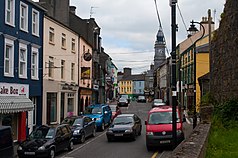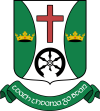Tuam
Tuaim (Irish) | |
|---|---|
Town | |
| Motto(s): Irish: Tuath Thuama go Buan "Long Live the People of Tuam" | |
| Coordinates: 53°30′54″N 8°51′04″W / 53.515°N 8.851°W | |
| Country | Ireland |
| Province | Connacht |
| County | County Galway |
| Municipal District | Tuam |
| Dáil constituency | Galway East |
| Area | |
• Total | 6.5 km2 (2.5 sq mi) |
| Elevation | 44 m (144 ft) |
| Population | |
• Total | 9,647 |
| • Density | 1,500/km2 (3,800/sq mi) |
| Eircode routing key | H54 |
| Telephone area code | +353(0)93 |
| Irish Grid Reference | M436521 |
| Website | tuam-guide |
| Year | Pop. | ±% |
|---|---|---|
| 1821 | 4,571 | — |
| 1831 | 6,883 | +50.6% |
| 1841 | 6,034 | −12.3% |
| 1851 | 4,929 | −18.3% |
| 1861 | 4,563 | −7.4% |
| 1871 | 4,223 | −7.5% |
| 1881 | 3,567 | −15.5% |
| 1891 | 3,012 | −15.6% |
| 1901 | 2,896 | −3.9% |
| 1911 | 2,980 | +2.9% |
| 1926 | 3,293 | +10.5% |
| 1936 | 4,181 | +27.0% |
| 1946 | 3,868 | −7.5% |
| 1951 | 4,010 | +3.7% |
| 1956 | 4,789 | +19.4% |
| 1961 | 4,732 | −1.2% |
| 1966 | 4,742 | +0.2% |
| 1971 | 4,952 | +4.4% |
| 1981 | 6,093 | +23.0% |
| 1986 | 6,039 | −0.9% |
| 1991 | 5,540 | −8.3% |
| 1996 | 5,627 | +1.6% |
| 2002 | 6,027 | +7.1% |
| 2006 | 6,885 | +14.2% |
| 2011 | 8,242 | +19.7% |
| 2016 | 8,767 | +6.4% |
| 2022 | 9,647 | +10.0% |
| [2][3][4][5][6][7] | ||
Tuam (/ˈtjuːəm/; Irish: Tuaim [ˈt̪ˠuəmʲ],[8] meaning 'mound' or 'burial-place') is a town in Ireland and the second-largest settlement in County Galway. It is west of the midlands of Ireland, about 35 km (22 mi) north of Galway city. Humans have lived in the area since the Bronze Age while the historic period dates from the sixth century. The town became increasingly important in the 11th and 12th centuries in political and religious aspects of Ireland. The market-based layout of the town and square indicates the importance of commerce.
The red Latin cross of the coat of arms is representative of Tuam's importance as an ecclesiastical centre. The double green flaunches at the sides, represent the two hills or shoulders of Tuam's ancient name, Tuaim Dhá Ghualainn. The two crowns recall the High Kings, Tairrdelbach and Ruaidrí, who were based in Tuam. The broken chariot wheel is a reference to the foundation of the monastic town when St Jarlath's chariot wheel broke. The motto of the town, Tuath Thuama go Buan, translates as "Long Live the People of Tuam".[9]
- ^ "Population Density and Area Size 2016". Central Statistics Office (Ireland). Retrieved 19 February 2019.
- ^ a b "Profile 1 - Population Distribution and Movement F1015 - Population: Tuam, Co. Galway". Central Statistics Office (Ireland). Retrieved 29 June 2023.
- ^ "Census for post 1821 figures". Cso.ie. Retrieved 19 March 2014.
- ^ "Histpop – The Online Historical Population Reports Website". www.histpop.org. Archived from the original on 7 May 2016.
- ^ "NISRA – Northern Ireland Statistics and Research Agency (c) 2013". Nisranew.nisra.gov.uk. 27 September 2010. Archived from the original on 17 February 2012. Retrieved 19 March 2014.
- ^ Lee, J. J. (1981). "On the accuracy of the Pre-famine Irish censuses". In Goldstrom, J. M.; Clarkson, L. A. (eds.). Irish Population, Economy, and Society: Essays in Honour of the Late K. H. Connell. Oxford, England: Clarendon Press.
- ^ Mokyr, Joel; O Grada, Cormac (November 1984). "New Developments in Irish Population History, 1700–1850". The Economic History Review. 37 (4): 473–488. doi:10.1111/j.1468-0289.1984.tb00344.x. hdl:10197/1406. Archived from the original on 4 December 2012.
- ^ "Tuaim / Tuam". logainm.ie. Irish Placenames Commission. Retrieved 7 November 2019.
- ^ Glimpses of Tuam Since the Famine, J.A. Claffey, ISBN 978-0-9530250-0-8, 1997, Publisher: Old Tuam Society




